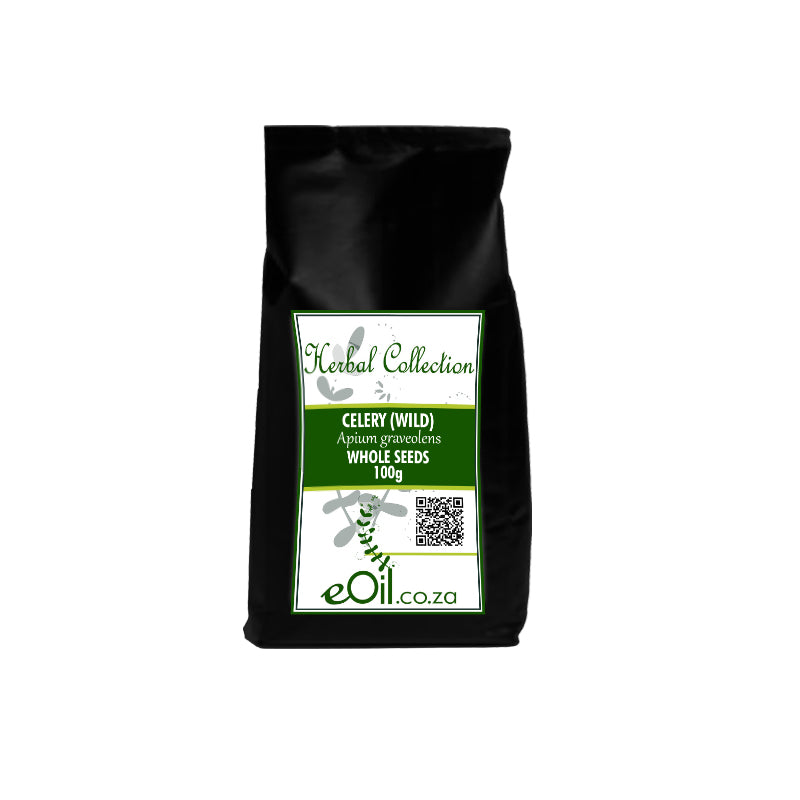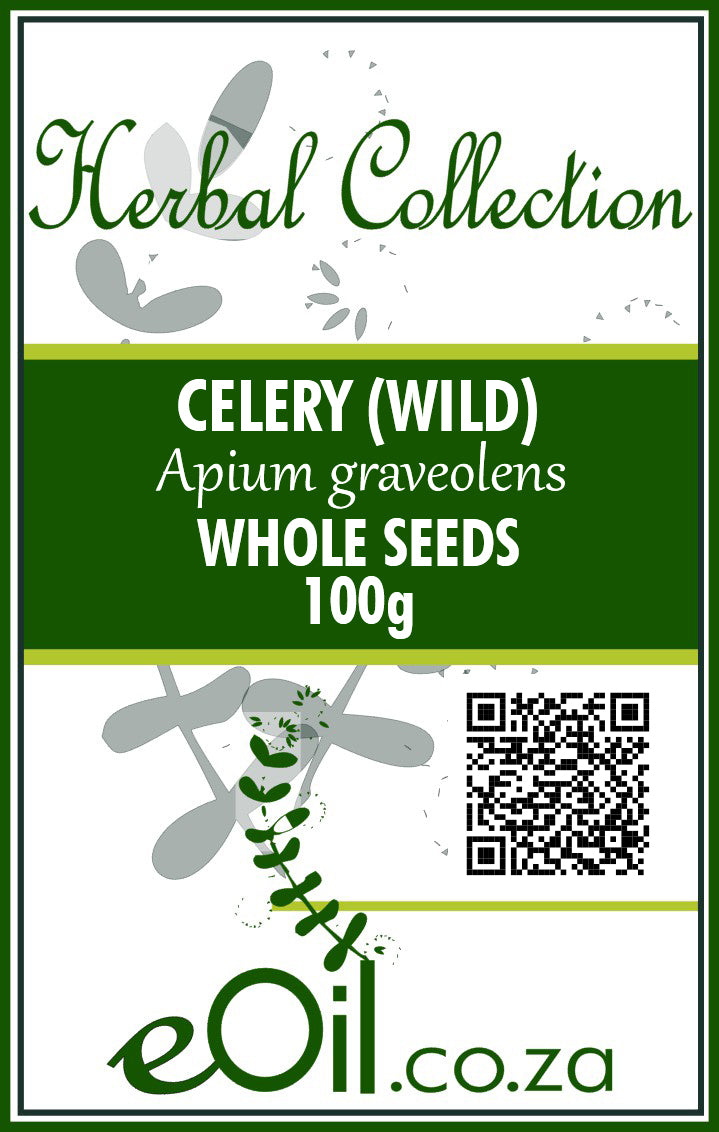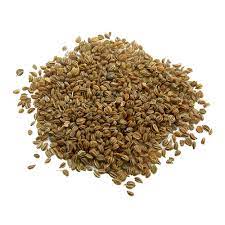Celery Seed Whole - Herbal Collection
Celery Seed Whole - Herbal Collection - 100 GR is backordered and will ship as soon as it is back in stock.
Description
Description
Celery Seed Whole (Apium graveolens) delivers a concentrated, earthy, and mildly spicy flavor, reminiscent of crisp celery.
Traditionally used in salads, soups, pickling, coleslaw, and spice blends, these tiny seeds add depth to a variety of culinary creations.
100% pure and additive-free
TRADITIONALLY USED FOR
Celery seeds (Apium graveolens) have been used for centuries in traditional medicine and cuisine around the world.
These tiny, light-brown seeds are derived from the wild celery plant and are packed with various properties and potential health benefits.
Some of the traditional uses, properties, and benefits of celery seeds include:
- Diuretic properties: Celery seeds have been traditionally used as a natural diuretic, helping to increase urine production and eliminate excess water from the body. This can be beneficial in managing conditions like high blood pressure, edema, and kidney disorders.
- Anti-inflammatory effects: Celery seeds contain compounds like luteolin and apigenin, which are known for their anti-inflammatory properties. These compounds may help reduce inflammation and alleviate symptoms associated with conditions like arthritis and gout.
- Antioxidant properties: Rich in antioxidants, celery seeds help neutralize free radicals and protect cells from oxidative damage. This can contribute to overall health and may help prevent chronic diseases.
- Digestive aid: Celery seeds have been used to promote digestion and soothe digestive issues like indigestion, gas, and bloating.
- Menstrual discomfort relief: Some traditional practices use celery seeds to alleviate menstrual cramps and discomfort due to their antispasmodic properties.
- Antimicrobial effects: Celery seeds have been known to exhibit antimicrobial properties, which may help protect against bacterial, fungal, and viral infections.
- Flavoring agent: In culinary applications, celery seeds are used as a spice and flavoring agent, adding a distinctive taste to dishes like soups, pickles, and salads.
INFORMATION
Source : http://www.wikiphyto.org/wiki/Ache_des_marais
Reference on http://www.wikiphyto.org
Translation in English by Google Translate (go to the page of the source linked | on Chrome cellphones go on the 3 dots on the top right and select translate in your preferred language | on laptop right click your mouse and select option translate when hoovering on the page
plant name
Swamp ache, celery , fragrant ache, marsh parsley
International Latin denomination
botanical family
Apiaceae ( Umbelliferae )
Description and habitat
- Biennial herbaceous plant with a strongly furrowed fistulous stem, thick and shiny leaves, divided into triangular segments, more petiolate at the base
- Salty and marshy soils of Europe, Africa and America
- Flowers in umbels, small and greenish white, globose achenes
- Apium graveolens var. graveolens is the marsh ache
- Apium graveolens var. dulce is stalk celery or ribbed celery
- Apium graveolens var. rapaceum is celeriac
- Apium graveolens var. secalinum is the celery to cut
History and tradition
- According to Lieutaghi, the genus name Apium comes from the Sanskrit Apya "which grows in water" .
- Cultivated forms constitute celery , the branches or root of which are eaten ( celeriac )
- Used in the form of “diuretic syrup” or “five-root syrup” with Ache , Asparagus , Fennel , Parsley , Buttercup
Parts used
- Root strain
- Fruits ( essential oil ), aerial parts
- Seed or root essential oil
Dosage forms available
- Mother tincture of Apium graveolens seed (fruit)
- Apium dulce mother tincture ( seed)
- Seed essential oil
Usual dosages
Composition
Main components of the plant
- Essential oil with monoterpenes : majority limonene and phthalides
- Furanocoumarins in the roots
- Alkaloids
- Flavonoids : apigenin ( flavone ), apiin
Main components of buds or young shoots
Main components of essential oil
- Seeds:
- Monoterpenes : majority limonene (fruits 60 to 70%, roots 9-30%), beta-pinene , myrcene , trans-ocimene (leaves)
- Sesquiterpenes : beta-selinene (10 to 30%) and alpha-selinene
- Phthalides (5-15%): 3-n-butylphthalide , sedanolide , senkyunolide-N , senkyunolide-J
- Coumarin ethers : ombelliprenine , celerine , apigravine
- Nerolidol , d-carvone , cis-limonene oxide
- In the sheets:
- Terpene esters : cis-carvyl acetate and trans-carvyl acetate
- In the roots:
Properties
Plant properties
- The whole plant is diuretic [1] , [2] , [3] , [4]
- Increases urinary calcium elimination, reduces calcium deposition in a mouse model of nephrocalcinosis [5]
- The fruits are tranquilizers and sedatives, analgesics, anticonvulsants by alkaloids
- Hypotensive, used for the indication of hypertension in traditional Chinese medicine
- Hypolipidemic [6]
- Hepatoprotective, the methanolic extract protects against damage caused by hepatotoxic compounds (paracetamol, thioacetamide) [7]
- Apiin is anti -inflammatory [8] , but celery seed extract is gastro-protective [9]
- Male and female aphrodisiac? (according to a medieval aphorism, “if the woman knew what celery does to the man, she would go and get it from Paris to Rome”)
- Celery contains androstenone (5α-androst-16-en-3-one), a pheromone found in mammalian urine and sweat, as does parsnip Pastinaca sativa
Bud properties
Properties of essential oil
- Tonic and antispasmodic
- Hepatocyte stimulant
- Digestive tonic, eupeptic, carminative, cholagogue
- Calming, sedative
- Venous decongestant
- Urinary antiseptic
- Antipigment
- Phthalides are preventive against certain chemo-induced gastric cancers [10] , the essential oil is anti-mutagenic [11] , [12] , decreases the formation of DNA adducts by aflatoxin B1 [13]
- 3-n-butylphthalide reduces accumulation of beta-amyloid protein, with potential action on Alzheimer's disease [14]
Directions
Indications of the whole plant (phytotherapy)
- hypertension in traditional chinese medicine
- Calcium and oxalic urolithiasis
- Sexual asthenia
- Poisoning
- Digestive disorders
Indications of the bud (gemmotherapy)
Specific indications of essential oil (aromatherapy)
- Liver and kidney failure
- Varicose veins, hemorrhoids
- Asthenia, depression, anxiety
- Insomnia, nervous disorders
- Cystitis, gout, renal detoxification
- Foul breath, slight hepatic insufficiency, flatulence
- Atherosclerosis
- Senile spots, of "old age"
- Cancer chemo-prevention
Known or suspected mode of action
- Limonene is expectorant
- Limonene protects against cancerization of the skin, liver, breast and colon
- Monoterpenes would be cortisone-like
- Phthalides are detoxifying
Usual formulations
Regulations
- French Pharmacopoeia list A (radical strain)
Possible side effects and precautions for use
- Risk of phyto-photodermatoses by contact with the plant then exposure to the sun (presence of furanocoumarins ( psoralen , xanthotoxin , bergapten ) in celery leaves
- The essential oil is not recommended for children under 6 years old, not recommended for pregnant women
- Risk of photosensitization. Do not apply before sun exposure
Bibliographic references
- Aller↑ Jenabi, E., & Fereidoony, B. (2015). Effect of Achillea millefolium on relief of primary dysmenorrhea: a double-blind randomized clinical trial. Journal of pediatric and adolescent gynecology, 28(5), 402-404.
- Aller↑ Mahran, GH, Kadry, HA, Isaac, ZG, Thabet, CK, Al‐Azizi, MM, & El‐Olemy, MM (1991). Investigation of diuretic drug plants. 1. Phytochemical screening and pharmacological evaluation of Anethum graveolens L., Apium graveolens L., Daucus carota L. and Eruca sativa mill. Phytotherapy Research, 5(4), 169-172.
- Aller↑ Fazal, SS, & Singla, RK (2012). Review on the pharmacognostic & pharmacological characterization of Apium graveolens Linn. Indo Global Journal of Pharmaceutical Sciences, 2(1), 36-42.
- Aller↑ Ishaq, H., Furqan, M., Sheikh, D., Raza, ML, Naqvi, BS, & Mehmood, T. (2016). Comparative study of ethanolic and aqueous extracts of Apium graveolens L. root with furosemide for its diuretic activity & excretion of urinary metabolites in Wistar rats. Science International, 28(3).
- Aller↑ Al Jawad, FH, Al Razzuqi, RA, & Al Jeboori, AA (2011). Apium graveolens accentuates urinary Ca+ 2 excretions in experimental model of nephrocalcinosis. International Journal of Green Pharmacy (IJGP), 5(2).
- Aller↑ D.Tsi, NP Das, BKH Tan. Effects of Aqueous Celery (Apium graveolens) Extract on Lipid Parameters of Rats Fed a High Fat Diet. PlantaMed 1995; 61(1): 18-21
- Aller↑ Anubha Singh, SS Handa. Hepatoprotective activity of Apium graveolens and Hygrophila auriculata against paracetamol and thioacetamide intoxication in rats. Journal of Ethnopharmacology, Volume 49, Issue 3, 15 December 1995, Pages 119-126
- Aller↑ T. Mencherini, A. Cau, G. Bianco, R. Della Loggia, RP Aquino, G. Autore. An extract of Apium graveolens var. dulce leaves: structure of the major constituent, apiin, and its anti-inflammatory properties. Journal of Pharmacy and Pharmacology, Volume 59, Issue 6, pages 891–897, June 2007
- Aller↑ MW Whitehouse, DE Butters, ML Clarke, KD Rainsford. NSAID gastropathy: prevention by celery seed extracts in disease-stressed rats. Inflammopharmacology 9(1):201-209 (2001)
- Aller↑ Guo-qiang Zhenga; Patrick M. Kenneya; Jilun Zhanga; Luke KT Lama. Chemoprevention of benzo[a]pyrene-induced stomach cancer in mice by natural phthalides from celery seed oil. Nutrition and Cancer, Volume 19, Issue 1 1993 , pages 77 - 86
- Aller↑ Sobti RC, Mittal OP, Anupinder Sachdeva, Gill GB. Anticlastogenic effect of essential oil to seeds of Apium graveolens. Cytologia, 1991, vol. 56, no2, pp. 303-308
- Aller↑ Guo-qiang Zheng, Patrick M. Kenney, Jilun Zhang, Luke KT Lam. Chemoprevention of benzo[a]pyrene-induced stomach cancer in mice by natural phthalides from celery seed oil. Nutrition and Cancer, Volume 19, Issue 1 1993 , pages 77 - 86
- Aller↑ Shehla Hashima; VS Aboobakerb; R. Madhubalaa; RK Bhattacharyab; AR Raoa. Modulatory effects of essential oils from spices on the formation of DNA adduct by aflatoxin B1 in vitro. Nutrition and Cancer, Volume 21, Issue 2 1994 , pages 169 - 175
- Aller↑ Peng Y, Sun J, Hon S, Nylander AN, Xia W, Feng Y, Wang X, Lemere CA. L-3-n-butylphthalide improves cognitive impairment and reduces amyloid-beta in a transgenic model of Alzheimer's disease. J Neurosci. 2010 Jun 16;30(24):8180-9. PMID 20554868
- John W. Uhlig, Alan Chang, Joseph J. Jen. Effect of Phthalides on Celery Flavor. Journal of Food Science, Volume 52, Issue 3, pages 658–660, May 1987
- Jagan Mohan Rao L, Nagalakshmi S, Pura Naik J, Shankaracharya NB Studies on chemical and technological aspects of celery (Apium graveolens. Linn) seed. Journal of food science and technology. 2000, vol. 37, no. 6, p. 631-635 (18 refs.) [1]
- Ludwiczuk A, Najda A, Wolski T, Baj T. Chromatographic determination of the content and the composition of extracts and essential oils from the fruits of three varieties of stalk celery (Apium graveolens L. var. dulce Mill. pers.). JPC. Journal of planar chromatography, modern TLC. 2001, vol. 14, no.6, pp. 400-404 (13 refs.) [2]
CAUTION
Store in a cool, dry place, away from light. Keep tightly closed, away from the reach of Children and pets.
Do not exceed the daily dose.
This product is not intended to prevent or cure any form of illness or disease.
If you are pregnant or nursing ; If you have a medical condition or are in the course of medical treatment ; If you are programmed for theater/operation in the near future, please consult your healthcare practitioner before using this product.
This product cannot replace a varied and balanced diet and a healthy lifestyle.
This product has not been evaluated by the SAHPRA for its quality, safety or intended use.
For More Information please check our General Safety Herbal products Page

Celery Seed Whole - Herbal Collection - 100 GR is backordered and will ship as soon as it is back in stock.






